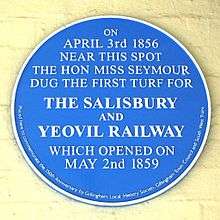Gillingham (Dorset) railway station
| Gillingham (Dorset) | |
|---|---|
 | |
| Location | |
| Place | Gillingham |
| Local authority | North Dorset |
| Coordinates | 51°02′02″N 2°16′23″W / 51.034°N 2.273°WCoordinates: 51°02′02″N 2°16′23″W / 51.034°N 2.273°W |
| Grid reference | ST809261 |
| Operations | |
| Station code | GIL |
| Managed by | South West Trains |
| Number of platforms | 2 |
| DfT category | D |
|
Live arrivals/departures, station information and onward connections from National Rail Enquiries | |
| Annual rail passenger usage* | |
| 2010/11 |
|
| 2011/12 |
|
| 2012/13 |
|
| 2013/14 |
|
| 2014/15 |
|
| History | |
| Original company | Salisbury and Yeovil Railway |
| Pre-grouping | London and South Western Railway |
| Post-grouping | Southern Railway |
| 1859 | Line opened from Salisbury |
| 1860 | Line extended westwards |
| 1967 | Line singled |
| National Rail – UK railway stations | |
| * Annual estimated passenger usage based on sales of tickets in stated financial year(s) which end or originate at Gillingham (Dorset) from Office of Rail and Road statistics. Methodology may vary year on year. | |
|
| |
Gillingham (Dorset) railway station is in Gillingham in Dorset, England. It opened in 1859 on the London Waterloo to Exeter line 105 miles (169 km) from London, and is managed by South West Trains.
History

On 3 April 1856 Miss Seymour, sister of the company’s chairman, dug the first ceremonial sod for the Salisbury and Yeovil Railway (S&YR) at Gillingham. Three years later, on 2 May 1859, the railway from Salisbury opened to Gillingham, and was completed to Hendford station at Yeovil on 1 June 1860. The station was close to the town centre. The main offices and goods shed were on the north side of the line, further sidings to serve a brickworks were added on the other side of the line, and a signal box opened in 1875. Trains were provided for the S&YR by the London and South Western Railway (LSWR), which bought out the smaller company in 1878. In the twentieth century the LSWR operated motor bus services from Gillingham station to Mere, Zeals and Shaftesbury.[1]
In 1923 the LSWR became part of the Southern Railway, which in turn was nationalised in 1948 to become the Southern Region of British Railways. A new signal box was opened on 28 April 1957, but on 5 April 1965 public goods services were withdrawn. Three years later a fertiliser distribution depot was opened in the old goods yard (it closed in 1993). The line had been transferred to the Western Region in 1963, and through trains beyond Exeter St Davids were soon diverted along other routes. The line was reduced to just a single track on 1 April 1967 with a passing loop retained at Gillingham.[1] Initially the single-track sections were 7-mile (11 km) westwards to Templecombe and 19-mile (31 km) eastwards to Wilton, but the latter was shortened to 9-mile (14 km)[2] in 1986.[1]
| Preceding station | Historical railways | Following station | ||
|---|---|---|---|---|
| Semley | London and South Western Railway London Waterloo to Devon and Cornwall |
Templecombe | ||
Description
The main offices, designed by Sir William Tite stand on the north side of the line.[1] The track serving this platform is signalled for trains to run in either direction so most trains use this platform unless two need to pass. The southern platform, which is reached by a footbridge, is then used for the westbound train. The former signal box (now reduced to ground frame status following the 2012 resignalling) is at the west end of the station by the end of this platform.[2][3]
Services

South West Trains operate hourly services between London Waterloo and Exeter St Davids and a service once on a Saturday between London Waterloo and Weymouth operating from late May to early September.[4]
| Preceding station | |
Following station | ||
|---|---|---|---|---|
| Tisbury | South West Trains West of England Main Line |
Templecombe or Terminus | ||
See also
| Wikimedia Commons has media related to Gillingham (Dorset) railway station. |
References
- 1 2 3 4 Phillips, Derek; Pryer, George (1997). The Salisbury to Exeter Line. Sparkford: Oxford Publishing Company. ISBN 0-86093-525-6.
- 1 2 Jacobs, Gerald (2005). Railway Track Diagrams Book 3: Western. Bradford-on-Avon: Trackmaps. ISBN 0-9549866-1-X.
- ↑ "Salisbury to Exeter Re-signalling Project 2012"Yeovil Railway Centre; Retrieved 8 June 2016
- ↑ Table 160 National Rail timetable, May 2016